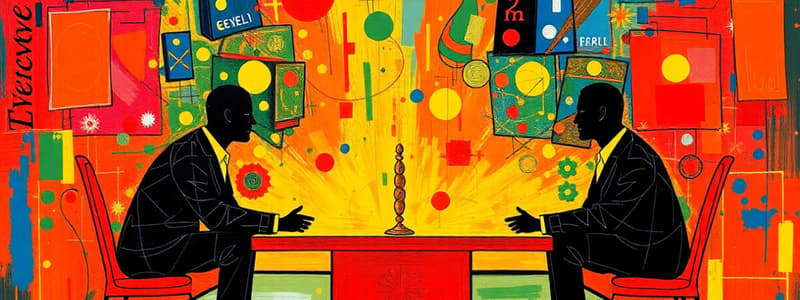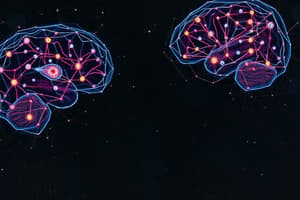Podcast
Questions and Answers
What is the main cognitive demand when dealing with unfair offers in decision-making?
What is the main cognitive demand when dealing with unfair offers in decision-making?
- Understanding the fairness of the offer
- Accumulating as much money as possible (correct)
- Evaluating social relationships
- Feeling empathy towards the proposer
Which brain region is associated with a bias toward rejection of unfair offers?
Which brain region is associated with a bias toward rejection of unfair offers?
- Anterior insula (correct)
- Hippocampus
- Amygdala
- DLPFC
What neural correlate has been implicated in the detection of cognitive conflict?
What neural correlate has been implicated in the detection of cognitive conflict?
- DLPFC
- Anterior cingulate cortex (ACC) (correct)
- Prefrontal cortex
- Temporal lobe
What was observed regarding DLPFC activation in relation to acceptance rates of unfair offers?
What was observed regarding DLPFC activation in relation to acceptance rates of unfair offers?
How does the anterior insula activity influence decision-making in the context of the Ultimatum Game?
How does the anterior insula activity influence decision-making in the context of the Ultimatum Game?
What aspect of decision-making does this study seek to understand?
What aspect of decision-making does this study seek to understand?
What has the anterior insula activation been shown to reflect in decision-making scenarios?
What has the anterior insula activation been shown to reflect in decision-making scenarios?
How does the study relate to broader concepts in society?
How does the study relate to broader concepts in society?
Which brain area showed significant activation in response to unfair offers from human partners compared to fair offers?
Which brain area showed significant activation in response to unfair offers from human partners compared to fair offers?
What was the primary focus of the analysis regarding offers made in the Ultimatum Game?
What was the primary focus of the analysis regarding offers made in the Ultimatum Game?
Which of the following regions is associated with negative emotional responses, particularly regarding unfair offers?
Which of the following regions is associated with negative emotional responses, particularly regarding unfair offers?
What is true regarding the participants' decisions about unfair offers?
What is true regarding the participants' decisions about unfair offers?
Which method was used to observe participant brain activity during the Ultimatum Game?
Which method was used to observe participant brain activity during the Ultimatum Game?
What did the significant activation in the bilateral anterior insula suggest about the participants' feelings?
What did the significant activation in the bilateral anterior insula suggest about the participants' feelings?
What was the significance level (P-value) indicating greater activation for unfair offers in the left insula?
What was the significance level (P-value) indicating greater activation for unfair offers in the left insula?
Which contrast was used to assess the activation related to unfair offers?
Which contrast was used to assess the activation related to unfair offers?
What is the goal of the proposer in the ultimatum game?
What is the goal of the proposer in the ultimatum game?
How do low offers (around 20% of the total) in the ultimatum game tend to be received?
How do low offers (around 20% of the total) in the ultimatum game tend to be received?
What does the empirical findings from the ultimatum game reveal about human social decision-making?
What does the empirical findings from the ultimatum game reveal about human social decision-making?
In the context of the ultimatum game, what can be inferred about modal offers?
In the context of the ultimatum game, what can be inferred about modal offers?
What is a significant limitation of the standard economic model as highlighted by the ultimatum game?
What is a significant limitation of the standard economic model as highlighted by the ultimatum game?
What role do cognitive and emotional processes play in the ultimatum game?
What role do cognitive and emotional processes play in the ultimatum game?
Which factor appears to strongly influence the acceptance or rejection of offers in the ultimatum game?
Which factor appears to strongly influence the acceptance or rejection of offers in the ultimatum game?
Based on the findings related to the ultimatum game, which statement is correct regarding human behavior in economic situations?
Based on the findings related to the ultimatum game, which statement is correct regarding human behavior in economic situations?
What does the research involving a GluR2 K882A knock-in mouse aim to test?
What does the research involving a GluR2 K882A knock-in mouse aim to test?
In the Ultimatum Game, what is the role of the second player?
In the Ultimatum Game, what is the role of the second player?
Which of the following techniques was used to study the neural substrates involved in the Ultimatum Game?
Which of the following techniques was used to study the neural substrates involved in the Ultimatum Game?
What limitation is highlighted regarding previous studies on cerebellar LTD and motor learning?
What limitation is highlighted regarding previous studies on cerebellar LTD and motor learning?
What areas of the brain showed increased activity in response to unfair offers in the Ultimatum Game?
What areas of the brain showed increased activity in response to unfair offers in the Ultimatum Game?
What is the significance of neuroeconomics as suggested in the content?
What is the significance of neuroeconomics as suggested in the content?
What does LTD stand for in the context of the cerebellum?
What does LTD stand for in the context of the cerebellum?
What role does PKC play in the signaling cascade related to cerebellar LTD?
What role does PKC play in the signaling cascade related to cerebellar LTD?
What role does phosphorylation of GluR2 Ser880 play in Purkinje cells?
What role does phosphorylation of GluR2 Ser880 play in Purkinje cells?
Why might the mutation of Lys882 interfere with receptor functions?
Why might the mutation of Lys882 interfere with receptor functions?
What conclusion can be drawn about PKC consensus sites on subunits other than GluR2?
What conclusion can be drawn about PKC consensus sites on subunits other than GluR2?
What is indicated by the correlation coefficient of the right insula in relation to unfair offers?
What is indicated by the correlation coefficient of the right insula in relation to unfair offers?
Which statement about the K882A mutation is correct?
Which statement about the K882A mutation is correct?
How does anterior insula activation compare with DLPFC activation in response to accepted offers?
How does anterior insula activation compare with DLPFC activation in response to accepted offers?
What is suggested by the results regarding the export of functional heteromeric receptor complexes?
What is suggested by the results regarding the export of functional heteromeric receptor complexes?
What does the contrast in activation between the anterior insula and DLPFC signify for accepted and rejected offers?
What does the contrast in activation between the anterior insula and DLPFC signify for accepted and rejected offers?
Which of the following compounds is likely to be used in the purification of polyclonal antiserum?
Which of the following compounds is likely to be used in the purification of polyclonal antiserum?
What role does the DLPFC typically play in decision-making according to the content?
What role does the DLPFC typically play in decision-making according to the content?
What does the presence of heteromeric receptor complexes involving GluR2 imply?
What does the presence of heteromeric receptor complexes involving GluR2 imply?
What do the findings suggest about the relationship between anterior insula activation and unfair offers?
What do the findings suggest about the relationship between anterior insula activation and unfair offers?
What is the significance of studies referenced by numbers (18), (33-35), and (36)?
What is the significance of studies referenced by numbers (18), (33-35), and (36)?
What does the term 'emotionally charged decision-making' refer to in this context?
What does the term 'emotionally charged decision-making' refer to in this context?
During decision-making, what is noted about the behavior of the anterior insula in relation to unfair offers?
During decision-making, what is noted about the behavior of the anterior insula in relation to unfair offers?
What statistical significance was found regarding the relationship between right anterior insular activity and decisions on unfair offers?
What statistical significance was found regarding the relationship between right anterior insular activity and decisions on unfair offers?
Flashcards
GluR2
GluR2
A protein subunit of the AMPA receptor, involved in regulating its trafficking and function.
LTD
LTD
A type of long-term synaptic weakening that weakens the connection between neurons.
Phosphorylation site
Phosphorylation site
A specific site on a protein that can be modified by the attachment of a phosphate group.
PKC
PKC
Signup and view all the flashcards
Ser880
Ser880
Signup and view all the flashcards
K882A
K882A
Signup and view all the flashcards
Heteromeric receptor complex
Heteromeric receptor complex
Signup and view all the flashcards
Trafficking
Trafficking
Signup and view all the flashcards
Motor learning
Motor learning
Signup and view all the flashcards
Long-term depression (LTD)
Long-term depression (LTD)
Signup and view all the flashcards
GluR2 K882A
GluR2 K882A
Signup and view all the flashcards
Glutamate
Glutamate
Signup and view all the flashcards
Neuroeconomics
Neuroeconomics
Signup and view all the flashcards
Ultimatum Game
Ultimatum Game
Signup and view all the flashcards
Functional Magnetic Resonance Imaging (fMRI)
Functional Magnetic Resonance Imaging (fMRI)
Signup and view all the flashcards
Prefrontal cortex
Prefrontal cortex
Signup and view all the flashcards
Offered Amount
Offered Amount
Signup and view all the flashcards
Modal Offer
Modal Offer
Signup and view all the flashcards
Low Offers
Low Offers
Signup and view all the flashcards
Rejection of Offer
Rejection of Offer
Signup and view all the flashcards
Neuroimaging Social Decision-Making
Neuroimaging Social Decision-Making
Signup and view all the flashcards
Standard Economic Model
Standard Economic Model
Signup and view all the flashcards
Behavioral Findings (Ultimatum Game)
Behavioral Findings (Ultimatum Game)
Signup and view all the flashcards
Anterior Insula
Anterior Insula
Signup and view all the flashcards
Dorsolateral Prefrontal Cortex (DLPFC)
Dorsolateral Prefrontal Cortex (DLPFC)
Signup and view all the flashcards
Rejection of Unfair Offers
Rejection of Unfair Offers
Signup and view all the flashcards
Brain Activity During Unfair Offers
Brain Activity During Unfair Offers
Signup and view all the flashcards
Brain Activity and Decision-Making
Brain Activity and Decision-Making
Signup and view all the flashcards
Competition between Brain Regions
Competition between Brain Regions
Signup and view all the flashcards
Balance between Emotion and Cognition
Balance between Emotion and Cognition
Signup and view all the flashcards
Different Roles of Brain Regions with Unfair Offers
Different Roles of Brain Regions with Unfair Offers
Signup and view all the flashcards
What is the Ultimatum Game?
What is the Ultimatum Game?
Signup and view all the flashcards
What is the anterior insula?
What is the anterior insula?
Signup and view all the flashcards
What is the DLPFC?
What is the DLPFC?
Signup and view all the flashcards
What is the ACC?
What is the ACC?
Signup and view all the flashcards
How is the anterior insula related to unfair offers?
How is the anterior insula related to unfair offers?
Signup and view all the flashcards
How does anterior insula activity influence decisions in the Ultimatum Game?
How does anterior insula activity influence decisions in the Ultimatum Game?
Signup and view all the flashcards
What did the study about the Ultimatum Game find regarding unfair offers from humans?
What did the study about the Ultimatum Game find regarding unfair offers from humans?
Signup and view all the flashcards
What are the key takeaways from the Ultimatum Game study?
What are the key takeaways from the Ultimatum Game study?
Signup and view all the flashcards
Acceptance of Unfair Offers
Acceptance of Unfair Offers
Signup and view all the flashcards
Cognitive Conflict
Cognitive Conflict
Signup and view all the flashcards
Neural System of Fairness
Neural System of Fairness
Signup and view all the flashcards
Relative Engagement of Brain Regions
Relative Engagement of Brain Regions
Signup and view all the flashcards
Cognitive and Emotional Processes in Decision-Making
Cognitive and Emotional Processes in Decision-Making
Signup and view all the flashcards
Study Notes
The Neural Basis of Economic Decision-Making in the Ultimatum Game
- Neuroeconomics seeks to link economic decision-making to brain processes.
- The Ultimatum Game involves two players splitting money. One proposes a split, the other accepts or rejects.
- Offers of unfair splits are often rejected, even when a small amount is accepted.
- Rejection of unfair offers is associated with heightened activity in the anterior insula (linked to emotion) and dorsolateral prefrontal cortex (linked to cognition).
- Standard economic models underestimate the role of emotions in decision-making.
- Unfair offers from humans trigger a stronger emotional response than unfair offers from computers.
- People reject unfair offers more often when the offer is made by a human than when the offer is made by a computer.
- Greater anterior insula activation correlates with rejection of unfair offers.
- Activity in dorsolateral prefrontal cortex doesn't correlate with acceptance rates but may compete with emotional areas in influencing decisions.
V1 Neurons Signal Acquisition of an Internal Representation of Stimulus Location
- Internal representation of stimulus location is vital for visuomotor tasks.
- Visual cortex responses change when an internal location representation is formed, depending on the location.
- Neuron responses are tuned to gaze direction, and the probability of stimulus appearance.
- Changes in neural response selectivity and dynamics occur in early visual cortex stages during internal representation acquisition, when location is known ahead of time.
Studying That Suits You
Use AI to generate personalized quizzes and flashcards to suit your learning preferences.
Related Documents
Description
Explore the intersection of neuroscience and economic decision-making through the lens of the Ultimatum Game. This quiz examines how brain activity influences our reactions to fair and unfair offers and emphasizes the emotional components of economic choices. Test your understanding of the neural mechanisms at play in economic behavior.




